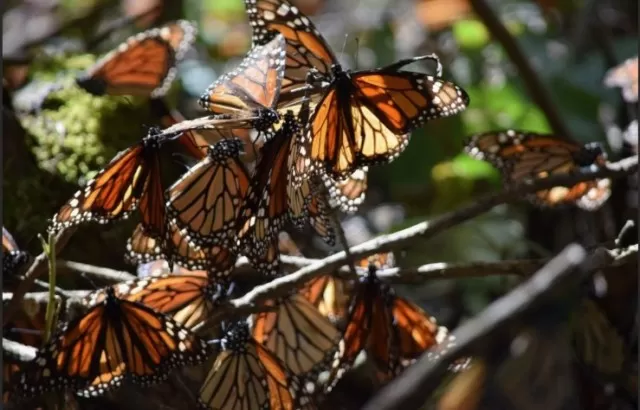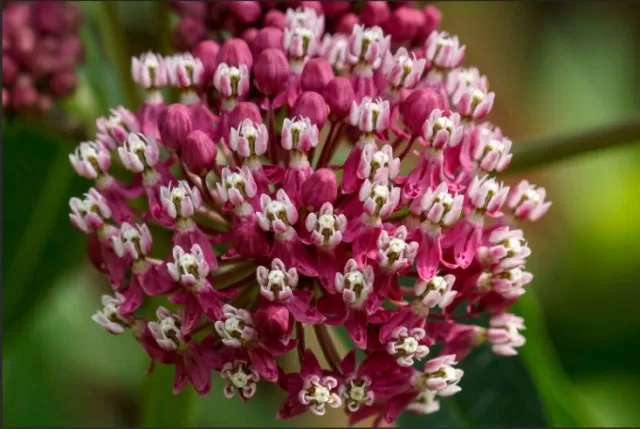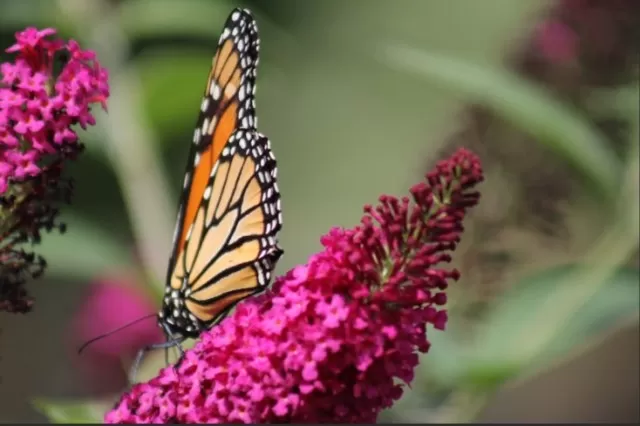Rescue Butterfly: Garden’s Vital Role. In this moment of urgency, as the monarch faces challenges that demand our collective attention, we are presented with a distinct opportunity to assume the role of providers.
It is within our power to extend the much-needed assistance that the monarch requires, thereby cementing our position as the reliable source of support in their time of need.Amidst the current situation, where the monarch finds themselves in a position of requiring support, an opportunity arises for us to step forward as the individuals uniquely equipped to offer the aid that is sought after.
Diminishing Monarch Populations: A Troubling Phenomenon

The enchanting monarch butterfly, renowned for its striking black and orange wings, holds a special place in the hearts of North Americans.
The graceful flutters of these butterflies amidst our gardens and their awe-inspiring journey spanning up to 3,000 miles to Mexico have long captivated our imaginations. Regrettably, the once-abundant monarchs have become a dwindling sight in the United States.
Over the past quarter-century, their numbers have plummeted dramatically, experiencing a staggering decline of 80 to 90 percent.
While the exact causes behind this disheartening decline remain elusive, it’s evident that a myriad of factors are at play.
Climate change, the relentless loss of natural habitats, widespread pesticide usage, and the prevailing practices of conventional agriculture all contribute to this ecological conundrum. These factors, acting in concert, pose an existential threat to the monarch population.
Nevertheless, armed with the knowledge of these challenges, we find ourselves at a critical juncture where our actions can make a difference.
By taking on the role of responsible stewards of the environment, we can substantially enhance the prospects for the monarchs’ survival. Reestablishing the delicate balance entails proactive measures such as the deliberate cultivation of milkweed and nectar plants, crucial sources of sustenance for the monarchs.
Furthermore, curtailing the use of harmful herbicides and pesticides is paramount.
By doing so, we not only safeguard the monarchs themselves but also mitigate the unintended consequences that ripple through ecosystems. This conscious shift in our practices aligns with a broader movement towards sustainable coexistence with the natural world.
Perhaps even more vital is the role of advocacy in the face of this crisis.
It falls upon us to champion the cause of the monarch butterflies and, by extension, the intricate web of life they symbolize. Armed with knowledge, we have the power to initiate positive change.
Spreading awareness, educating others, and inspiring collective action can catalyze a ripple effect of positive transformation.
In conclusion, the decline of monarch populations serves as a poignant reminder of our shared responsibility towards the delicate balance of the natural world.
Through deliberate actions, informed choices, and impassioned advocacy, we can steer the trajectory of these magnificent butterflies away from the precipice of extinction. The time to act is now, as the fate of the monarchs rests in our hands.
Challenge: Decline in Milkweed Availability Threatens Monarch Survival
In the not-so-distant past, the majestic monarch butterflies reigned over the vast prairies and idyllic rural landscapes of the United States and southern Canada.
These enchanting creatures thrived in a harmonious relationship with the sprawling natural habitat that surrounded them. However, the tranquility of their once-thriving domain has been disrupted by the encroachment of urbanization and the expansion of agricultural endeavors. As a consequence, the essential balance of their ecosystem has been thrown into disarray, and one critical element of their existence is in jeopardy—the availability of milkweed.
The intricate bond between monarch butterflies and milkweed plants is nothing short of essential.
For these winged wonders, milkweed is not just another plant; it’s the very foundation of their lifecycle. A single plant species, milkweed serves as the exclusive host for monarch reproduction, offering a sanctuary for their eggs to hatch, caterpillars to feed, and pupae to develop.
It’s a profound and delicate connection that has evolved over millennia, nurturing the intricate dance of life between these two species.
Yet, the serene landscapes that once flourished with abundant milkweed now bear the scars of progress.
Urban sprawl and the relentless march of agriculture have chipped away at the natural acreage that monarchs once called home. The result has been a disheartening decline in milkweed populations, leaving monarchs in a perilous predicament.
Without this essential plant, their survival is imperiled, and the delicate balance that sustained their populations for generations now teeters on the brink of disruption.
The urgency of this challenge cannot be overstated.
As milkweed diminishes, so too does the monarch population. The striking black and orange wings that once graced our skies and gardens are becoming scarcer, casting a shadow over the future of these iconic butterflies.
To reverse this disheartening trend, a concerted effort is required—a symphony of conservation, education, and advocacy that seeks to restore milkweed to its rightful place in the landscape.
Communities, conservationists, and individuals alike must unite to stem the tide of milkweed decline.
Through strategic planting initiatives, habitat restoration projects, and the promotion of sustainable agricultural practices, we can begin to rekindle the once-vibrant connection between monarchs and milkweed. Moreover, public awareness campaigns can serve as a rallying cry, inspiring people to recognize the crucial role of milkweed in the monarch lifecycle and sparking a collective commitment to its preservation.
In conclusion, the dwindling availability of milkweed stands as a critical crossroads for the future of monarch butterflies.
The decline of this pivotal plant is not only a reflection of changing landscapes but also a harbinger of the delicate balance that sustains our natural world. By addressing this challenge with urgency, determination, and a shared commitment to ecological harmony, we have the power to ensure that the splendid dance of monarchs amidst milkweed continues to enchant generations to come.
Solution: Cultivate Milkweed to Nurture Monarchs

Unveiling the Truth about Milkweed: A Native Wildflower’s Crucial Role.
In a curious twist of terminology, the name “milkweed” might suggest a common weed, yet beneath its unassuming facade lies a native wildflower of profound significance.
Across the United States, a diverse array of more than 70 milkweed species emerges, each intimately attuned to the unique ecosystems of its respective state. Unveiling a secret world of ecological interdependence, these wildflowers hold the key to fostering monarch-friendly environments, where the splendor of these iconic butterflies can flourish once again.
The act of planting milkweed isn’t just a gesture—it’s a catalyst for change.
To champion the revival of monarch populations, individuals can actively participate by integrating milkweed into their gardens and landscapes. A strategic approach is necessary, as the majority of perennial milkweed species necessitate a natural process known as cold moist stratification to initiate germination.
Fall emerges as the opportune season to sow these seeds, entrusting them to the wintry embrace that will eventually coax them to life as spring dawns.
Planting the seeds unfolds as a ritual of hope.
Begin by delicately disturbing the top layer of soil, creating a hospitable bed for the forthcoming seeds. A gentle scattering of the seeds, followed by a gentle press into the earth, heralds the first steps towards rekindling the delicate dance between monarchs and their life-giving wildflowers.
Remarkably, most milkweed species require light to spring to life; a mere whisper of soil is sufficient to shelter these nascent seeds as they awaken to their transformative journey.
Yet, should the fall season elude your planting endeavors, fear not, for nature’s blueprint offers an alternative.
Mirroring the cold moist stratification process, a method of mimicry unfolds. Seeds are carefully arranged atop damp paper towels, hidden within a protective embrace of another moist towel.
A chilled sojourn within the confines of a refrigerator—lasting between 4 to 6 weeks—prepares these embryonic treasures for their eventual introduction to the world outside.
A further revelation for successful germination rests in the warming embrace of water.
By allowing the seeds to rest within a bath of tepid water overnight, nature’s call to life is amplified, ensuring that when these seeds meet the earth, their metamorphosis is irreversible.
In unveiling the hidden potential of milkweed, we partake in an intricate tale of coexistence—a narrative woven through generations, spanning species.
The effort to restore milkweed to its rightful place within our landscapes embarks on a quest to breathe life back into a fragile equilibrium disrupted by modern progress. With each seed sown, each tender shoot that emerges, we reimagine the landscapes where monarchs once thrived.
So, let us stand as stewards of this delicate dance, custodians of the connection between milkweed and monarchs.
With our hands in the soil and our hearts attuned to the rhythms of nature, we can revitalize not just a flower, but an entire ecosystem. As we sow the seeds of change, we nurture the future of monarchs, cultivating a legacy of beauty and balance that will endure for generations to come.
Dilemma: Balancing Garden Aesthetics with Ecological Impact
Striking the Right Chord: The Complex Nexus of Tropical Milkweed in Monarch Conservation.
In the hushed sanctuaries of our gardens, a conundrum of ecological consequence and visual delight unfolds—a tangle of controversy rooted in the cultivation of tropical milkweed (Asclepias curassavica).
As this non-native annual takes root, it unravels a delicate tapestry of concerns that stretch beyond aesthetics, delving into the intricate interplay between human actions and the well-being of our revered monarch butterflies.
In the sun-soaked landscapes of the South, gardeners have embraced the allure of tropical milkweed, drawn to its vibrant blooms and the seemingly effortless grace with which it thrives.
Yet, concealed beneath its resplendent exterior lies a web of questions that challenge our understanding of ecological harmony. The heart of this dilemma lies in the clash between garden aesthetics and the potential ecological consequences that unfurl in the wake of its proliferation.
The contentiousness surrounding tropical milkweed stems from its role in the monarchs’ migratory journey—a saga that unfolds across vast distances, uniting continents in a symphony of nature’s wonder.
Some scholars hold the belief that the continuous presence of non-native tropical milkweed, which remains green during the winter months, disrupts the monarchs’ natural migration patterns. This artificial haven tempts these delicate creatures to linger, causing them to forego their instinctual journey southward.
The disruption caused by this seemingly benign action reverberates through the monarch population, potentially rendering them vulnerable to a cascade of unforeseen consequences.
Another shadow cast by the presence of tropical milkweed is the insidious spread of OE, a parasitic protozoan that infiltrates the bodies of these regal insects, inducing a host of deformities.
The flowering allure of this non-native species inadvertently beckons monarchs to linger, extending their exposure to this parasitic threat. While the precise extent of this risk remains a subject of study, the potential ramifications loom large, a cautionary tale of unintended consequences in the realm of ecological interdependence.
As we navigate the complex crossroads of this dilemma, a harmony between garden aesthetics and ecological preservation must be struck.
The path forward necessitates a nuanced approach—one that considers not just the immediate visual gratification, but the profound implications that extend beyond our garden fences. In regions where tropical milkweed thrives, a cycle of mindful management emerges.
Regular pruning to prevent overgrowth during the winter months and replacing it with native milkweed when possible can mitigate the potential risks associated with its continuous presence.
Education emerges as an equal partner in this endeavor.
Empowering gardeners with knowledge about the potential impacts of their choices infuses every planting decision with a sense of purpose and ecological mindfulness. Armed with information, we find ourselves better equipped to make decisions that honor both the aesthetic and the ecological dimensions of our gardens.
In the tapestry of nature, each thread contributes to the grand narrative that sustains life’s intricate dance.
By embracing a thoughtful and informed approach to the cultivation of tropical milkweed, we can weave a story of balance—a story that speaks of our commitment to the well-being of the monarchs, of our reverence for the ecosystems they inhabit, and of our collective role as custodians of this fragile planet we call home.
Sustainable Cultivation: Nurturing Monarchs Through Thoughtful Planting

Amidst the discourse surrounding the role of tropical milkweed in monarch conservation, a pragmatic approach emerges—one that harmonizes divergent viewpoints while upholding the well-being of these majestic butterflies.
While the potential impact of tropical milkweed on monarchs remains a subject of debate, informed actions can pave the way for a balanced and ecologically conscious approach to gardening.
For those who opt to embrace the allure of tropical milkweed, a measured strategy can mitigate potential disruptions.
As winter approaches, a ritual of renewal takes center stage—cutting back the tropical milkweed to the very ground from which it sprang. This thoughtful act allows for a fresh canvas of growth to emerge with the arrival of spring, promoting a cycle that mirrors nature’s rhythm.
However, a broader array of alternatives beckons to those who seek to foster monarch-friendly habitats while minimizing potential risks.
Native milkweed species, long adapted to the landscapes of North America, stand as beacons of ecological resilience. The tapestry of options unfurls across the continent, with approximately 30 native milkweed species embraced by monarchs as vital hosts for their eggs and caterpillars.
East of the Rockies, the iconic monarch-favored varieties include common milkweed (Asclepias syriaca) and the elegant swamp milkweed (A.
incarnata). The antelope horn milkweed (A.
viridis and A. asperula) holds a special place in the hearts of these butterflies.
West of the Rockies, showy milkweed (A. speciosa) takes the stage, offering a compelling choice for gardeners seeking to foster monarch habitats.
Among these native options, butterfly weed (A. tuberosa) emerges as a favorite, adorned with captivating orange blooms that earned it the title of Perennial Plant of the Year in 2017.
This vibrant tapestry also includes the sunny ‘Hello Yellow’ cultivar.
While monarchs will indeed utilize butterfly weed, the textural nuances of its leaves may not make it their foremost preference.
This exemplifies the intricate dance of ecological relationships—how subtleties in texture can influence species interactions in ways we are only beginning to comprehend.
As stewards of our gardens and guardians of these enchanting butterflies, we find ourselves positioned at the nexus of choice and responsibility.
The journey towards a harmonious coexistence requires that we tread thoughtfully, embracing the spectrum of knowledge at our disposal. By selecting native milkweed species with care, we can cultivate vibrant habitats that echo the rhythms of nature.
With each decision, we contribute to the intricate tapestry of life, nurturing a legacy of balance that bridges the divide between our desire for garden beauty and our commitment to the conservation of these iconic creatures.
*The information is for reference only.